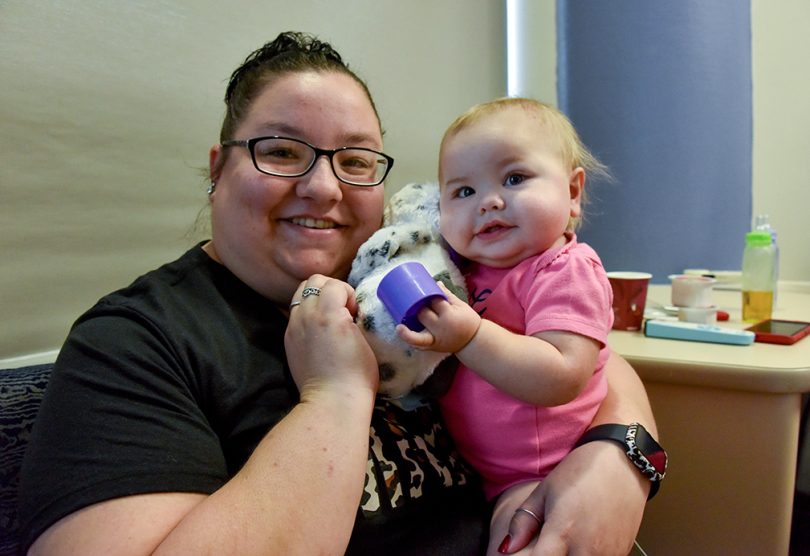If Caitlyn Widener could have a holiday wish, it would be to give her daughter a kidney.
With chubby cheeks and bright blue eyes, 18-month-old Addisynn Widener sat next to her mother at Children’s Hospital of Georgia, snuggling a stuffed owl and playing patty-cake with her mom’s hands.
Fighting back tears, Widener recalled the difficult days after her daughter’s premature birth due to preeclampsia.
“We knew something was going on with her kidney, but we didn’t know the extent. We thought there was a blockage somewhere,” she said. “They told us she was in kidney failure. Her left kidney doesn’t work at all. Her right kidney only halfway functions. Only half of it works.”
When Addisynn grows a little more and gains more weight, she will be eligible to get a kidney transplant, and a living donor will be her best bet. Widener plans to be tested, as will her family, to see if she or someone in the family can provide a match. If one is not found within the family, Addisynn will need a donor – preferably a living donor.
Many adults may not realize that they can donate a kidney to help a child.
Nationwide, 1,918 children are awaiting kidney transplants, according to the Scientific Registry of Transplant Recipients (SRTR).
The Children’s Hospital of Georgia currently has seven children under 18 on the transplant list.
Most transplants are performed using a deceased donor’s kidneys. But so many more children – like Addisynn – could be helped if more altruistic living donors are willing to donate one of their kidneys.
There is a great need for living donors in Georgia, said Dr. Ahmad Mirza, pediatric surgical transplant director at AU Health and Children’s Hospital of Georgia.
“Many of the children are coming from medically underserved areas, and they’re coming from very small communities. So they are unable to find living donors within the small pool of people they know by blood or by community relations,” he said. “This is a call out there for people living in Georgia to come forward of their own free will to help these children.”
Pediatric patients who receive a kidney from a deceased donor do well – AU Health and Children’s has a nearly 100% success rate in the program’s 52-year history – but “the longevity of an organ from a living donation is far superior to a donor who is deceased,” Mirza said. “So is the number of complications that happen is far less than with living donation.”
According to the SRTR, in 2019 only 32% of kidneys for pediatric patients were transplanted from living donors, and that number is decreasing.
Mirza mentioned living donation as a very safe procedure. Donors must go through a thorough evaluation to determine their suitability and immunological compatibility. The ideal donor is relatively young and in good health.
During the donation, the kidney is removed from the donor and placed directly into the child. The donor will remain in the hospital for at least three days, with a minimum of two follow up appointments.
“We have the best team of doctors, including urologists, nephrologists, kidney transplant surgeons, which work tirelessly to take care of patients and to help their lives return to normal as quickly as possible,” said Dr. Asif Mansuri, medical director for the pediatric transplant program.
Mansuri also added that post-transplant, it is also very important for patients to follow up with their kidney transplant team on a regular basis and follow their advice. Most children are ready to return to school within three months, a few hours each day until they can tolerate a full day.
Following the surgery, donors can expect to return to work after four weeks and must avoid lifting heavy objects for about three months as the wound heals. They can expect to return to a completely normal life, adhering to a healthy lifestyle that includes drinking plenty of water and avoiding ingesting things that could harm their remaining kidney.
Children’s Hospital of Georgia offers comprehensive pediatric nephrology services and is one of only two providers in the state that can do kidney transplants.
For more information about becoming a living donor, call Christina Wiggins, kidney transplant coordinator, at 706-721-0854.


